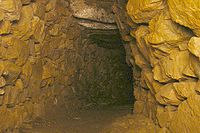
Halliggye Fogou
Encyclopedia

Fogou
A fogou or fougou is an underground, dry-stone structure found on Iron Age or Romano-British defended settlement sites in Cornwall. Fogous have similarities with souterrains or earth-houses of northern Europe and particularly Scotland including the Orkney Islands...
s in Cornwall
Cornwall
Cornwall is a unitary authority and ceremonial county of England, within the United Kingdom. It is bordered to the north and west by the Celtic Sea, to the south by the English Channel, and to the east by the county of Devon, over the River Tamar. Cornwall has a population of , and covers an area of...
, England, United Kingdom.
The site is under the guardianship of English Heritage
English Heritage
English Heritage . is an executive non-departmental public body of the British Government sponsored by the Department for Culture, Media and Sport...
, and managed by The Trelowarren Estate. Although entry to the fogou is free (2011), there is a charge to enter the rest of the Trelowarren Estate.
Located in Trelowarren estate, near Helston
Helston
Helston is a town and civil parish in Cornwall, England, United Kingdom. It is situated at the northern end of the Lizard Peninsula approximately 12 miles east of Penzance and nine miles southwest of Falmouth. Helston is the most southerly town in the UK and is around further south than...
, it consists of a long narrow tunnel leading to three sectioned chambers, and a window-like entrance which was dug in Victorian times by supposed treasure hunters (this has recently been filled in).
The complex of passages has a roof and walls of stone, and is the largest and best-preserved of several mysterious underground tunnels associated with Cornish Iron Age settlements.
It was described by Sir Richard Vyvyan
Sir Richard Vyvyan, 8th Baronet
Sir Richard Rawlinson Vyvyan, 8th Baronet was an English landowner and Whig and Liberal politician who sat in the House of Commons variously between 1825 and 1857.-Early life:...
in his "Account of the ‘fogou’ or cave at Halligey, Trelowarren", in the Journal of the Royal Institution of Cornwall (1885, viii. 256-58) In 1861, J. T. Blight wrote a comprehensive description and drafted plans of the fogou in conjunction with Sir Richard Vyvyan, the landowner who listed finds as a vase containing ashes and a roughly made cup, both of Celtic manufacture, and animal bones possibly from a deer.
In the 1980s, a series of small excavations were carried out by English Heritage mainly to clear debris from the passage to aid examination and repair work after routine ploughing of the field, when the blade of the plough breached the roof of the main chamber: this hole has since been turned into an entrance stairway for visitors. Pottery found during excavations has included local Iron Age cordoned wares and some sherds of Roman Samian ware from southern Gaul.
It was used during the Second World War by the Manaccan Auxiliary Unit as an explosives and ammunition store.

